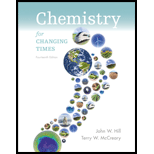
Concept explainers
(a)
Interpretation: Name the following hydrocarbon should be determined.

Concept Introduction:
While naming hydrocarbons, we use several prefixes in order to state the total number of carbons present. For example: In propane, butane, pentane, the suffix -ane represents hydrocarbon chain and prefixes, -prop, -but and -pent represents three, four and five carbons in the hydrocarbon chain. Also, if there is any substituent or group present at any position then the naming of hydrocarbon is done in such a way that it represents the position of that substituent.
(b)
Interpretation: Name the following hydrocarbon should be determined.

Concept Introduction:
While naming hydrocarbons, we use several prefixes in order to state the total number of carbons present. For example: In propane, butane, pentane, the suffix -ane represents hydrocarbon chain and prefixes, -prop, -but and -pent represents three, four and five carbons in the hydrocarbon chain. Also, if there is any substituent or group present at any position then the naming of hydrocarbon is done in such a way that it represents the position of that substituent.
(c)
Interpretation: Name the following hydrocarbon should be determined.

Concept Introduction:
While naming hydrocarbons, we use several prefixes in order to state the total number of carbons present. For example: In propane, butane, pentane, the suffix -ane represents hydrocarbon chain and prefixes, -prop, -but and -pent represents three, four and five carbons in the hydrocarbon chain. Also, if there is any substituent or group present at any position then the naming of hydrocarbon is done in such a way that it represents the position of that substituent.
Want to see the full answer?
Check out a sample textbook solution
Chapter 9 Solutions
Chemistry for Changing Times
- What is the final product when hexanedioic acid reacts with 1º PCl5 and 2º NH3.arrow_forwardWhat is the final product when D-galactose reacts with hydroxylamine?arrow_forwardIndicate the formula of the product obtained by reacting methyl 5-chloro-5-oxopentanoate with 1 mole of 4-penten-1-ylmagnesium bromide.arrow_forward
- The temperature on a sample of pure X held at 1.25 atm and -54. °C is increased until the sample boils. The temperature is then held constant and the pressure is decreased by 0.42 atm. On the phase diagram below draw a path that shows this set of changes. pressure (atm) 2 0 0 200 400 temperature (K) Xarrow_forwardQUESTION: Answer Question 5: 'Calculating standard error of regression' STEP 1 by filling in all the empty green boxes *The values are all provided in the photo attached*arrow_forwardpressure (atm) 3 The pressure on a sample of pure X held at 47. °C and 0.88 atm is increased until the sample condenses. The pressure is then held constant and the temperature is decreased by 82. °C. On the phase diagram below draw a path that shows this set of changes. 0 0 200 temperature (K) 400 аarrow_forward
 ChemistryChemistryISBN:9781305957404Author:Steven S. Zumdahl, Susan A. Zumdahl, Donald J. DeCostePublisher:Cengage Learning
ChemistryChemistryISBN:9781305957404Author:Steven S. Zumdahl, Susan A. Zumdahl, Donald J. DeCostePublisher:Cengage Learning ChemistryChemistryISBN:9781259911156Author:Raymond Chang Dr., Jason Overby ProfessorPublisher:McGraw-Hill Education
ChemistryChemistryISBN:9781259911156Author:Raymond Chang Dr., Jason Overby ProfessorPublisher:McGraw-Hill Education Principles of Instrumental AnalysisChemistryISBN:9781305577213Author:Douglas A. Skoog, F. James Holler, Stanley R. CrouchPublisher:Cengage Learning
Principles of Instrumental AnalysisChemistryISBN:9781305577213Author:Douglas A. Skoog, F. James Holler, Stanley R. CrouchPublisher:Cengage Learning Organic ChemistryChemistryISBN:9780078021558Author:Janice Gorzynski Smith Dr.Publisher:McGraw-Hill Education
Organic ChemistryChemistryISBN:9780078021558Author:Janice Gorzynski Smith Dr.Publisher:McGraw-Hill Education Chemistry: Principles and ReactionsChemistryISBN:9781305079373Author:William L. Masterton, Cecile N. HurleyPublisher:Cengage Learning
Chemistry: Principles and ReactionsChemistryISBN:9781305079373Author:William L. Masterton, Cecile N. HurleyPublisher:Cengage Learning Elementary Principles of Chemical Processes, Bind...ChemistryISBN:9781118431221Author:Richard M. Felder, Ronald W. Rousseau, Lisa G. BullardPublisher:WILEY
Elementary Principles of Chemical Processes, Bind...ChemistryISBN:9781118431221Author:Richard M. Felder, Ronald W. Rousseau, Lisa G. BullardPublisher:WILEY





